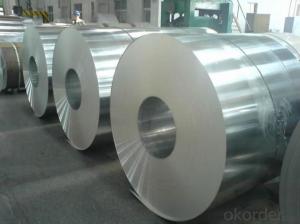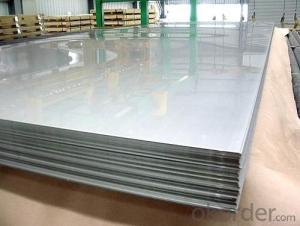Stainless Steel Sheets
- Loading Port:
- China Main Port
- Payment Terms:
- TT or LC
- Min Order Qty:
- 1 Ton m.t.
- Supply Capability:
- 3000 Tons Per Month m.t./month
OKorder Service Pledge
OKorder Financial Service
You Might Also Like
316L Stainless steel sheet
1. Chemical composition
|
C |
Si |
Mn |
P |
S |
Ni |
Cr |
|
Max0.03 |
max1.00 |
max2.00 |
max0.045 |
max0.03 |
10.00-14.00 |
16.00-18.00 |
2. Mechanical properties
|
Yield Strength |
Tensile |
Elongation |
Hardness (HV) |
Hardness (HRB) |
|
≥175 |
≥480 |
≥40 |
≤200 |
≤90 |
3. Standard: AISI, ASTM, GB, EN, DIN, JIS
4. Surface: 2B, NO.1, BA, NO.4, Hairline, SB, Mirror finish, Anti-skid, Cherkered etc.
5. Size: Thickness: 0.3-3mm (cold rolled), 3-40mm (hot rolled)
Width: 1000mm or 1219mm or 1240mm for cold rolled, 1500mm for hot rolled.
Length: As customers' request.
Length: As customers' request.
6. MOQ: 1 Ton
7. Payment terms: T/T or L/C
8. Packing: Seaworthy package with wooden or Iron pallets with the paper and the steel strip, or as customers' request.
9. Delivery time: Usually about 7 days after we confirming the order, or according to your quantity.
If you have any question or demand, pls feel free to contact me.


- Q: What are the different types of finishes for stainless steel strips?
- There are several different types of finishes for stainless steel strips, including brushed, mirror, satin, and embossed finishes.
- Q: How do you prevent microbiologically influenced corrosion of stainless steel strips?
- Microbiologically influenced corrosion of stainless steel strips can be prevented by implementing measures such as regular cleaning and maintenance, applying protective coatings or inhibitors, controlling the environment to minimize microbial growth, and using stainless steel grades with higher resistance to microbiological attack.
- Q: Can stainless steel strips be used in the production of electrical connectors?
- Yes, stainless steel strips can be used in the production of electrical connectors. Stainless steel is a highly versatile and corrosion-resistant material that is commonly used in electrical connectors due to its excellent conductivity and durability. It can be easily formed into various shapes and sizes, making it suitable for manufacturing different types of connectors.
- Q: Can 111 stainless steel strips be coated or plated for added protection?
- Yes, 111 stainless steel strips can be coated or plated for added protection.
- Q: Are 111 stainless steel strips resistant to pitting and crevice corrosion?
- Yes, 111 stainless steel strips are resistant to pitting and crevice corrosion. Stainless steel grade 111, also known as AISI 111, is a high-performance austenitic stainless steel alloy that contains a high level of chromium, which provides excellent corrosion resistance. The addition of molybdenum further enhances its resistance to pitting and crevice corrosion, making it suitable for various applications where these types of corrosion are a concern. Therefore, 111 stainless steel strips are a reliable choice when corrosion resistance is required.
- Q: Can stainless steel strips be machined?
- Stainless steel strips are indeed capable of being machined. Machining stainless steel strips encompasses a range of procedures, including cutting, drilling, milling, and turning. Nevertheless, it is crucial to acknowledge that stainless steel poses a challenge due to its hardness, necessitating the utilization of suitable tools and techniques for machining. Furthermore, the ease and efficacy of the machining process are contingent upon the particular kind of stainless steel and its inherent properties.
- Q: Can stainless steel strips be used in the oil refinery equipment?
- Yes, stainless steel strips can be used in oil refinery equipment. Stainless steel is highly resistant to corrosion and high temperatures, making it suitable for use in the harsh conditions of an oil refinery. It has excellent strength and durability, which allows it to withstand the corrosive and abrasive nature of oil refining processes. Additionally, stainless steel strips can be easily formed and fabricated into various shapes and sizes required for oil refinery equipment.
- Q: Can stainless steel strips be used for automotive suspension components?
- Automotive suspension components can indeed utilize stainless steel strips. Renowned for its remarkable strength, resistance to corrosion, and durability, stainless steel proves to be a fitting material for diverse automotive uses, including suspension components. Springs, brackets, and other crucial parts necessary for the suspension system can be efficiently manufactured using stainless steel strips. These components must endure substantial loads, vibrations, and exposure to varying environmental conditions, and stainless steel's properties establish it as a dependable choice for such rigorous applications. Furthermore, the corrosion resistance of stainless steel guarantees an extended lifespan for suspension components, even in the face of harsh conditions. Thus, stainless steel strips present a practical alternative for automotive suspension components.
- Q: Can stainless steel strips be used for decorative purposes?
- Yes, stainless steel strips can be used for decorative purposes. They are often used in architecture, interior design, and various decorative applications due to their sleek and modern appearance. Additionally, stainless steel is highly durable, resistant to corrosion, and easy to clean, making it an excellent choice for decorative purposes.
- Q: What are the common thicknesses of stainless steel strips?
- The intended application and industry standards dictate the common thicknesses of stainless steel strips. Among the frequently employed thicknesses for these strips are 0.1mm to 3mm. These thicknesses find extensive usage in construction, automotive, aerospace, and manufacturing sectors. It should be noted that the specific application may necessitate different thickness requirements. Hence, it is advisable to refer to industry standards and specifications to ensure the appropriate thickness is chosen for a specific project.
1. Manufacturer Overview
| Location | Zhejiang,China |
| Year Established | 2010 |
| Annual Output Value | Above US$16Million |
| Main Markets | Japan, South America |
| Company Certifications | ISO9001:2000; |
2. Manufacturer Certificates
| a) Certification Name | |
| Range | |
| Reference | |
| Validity Period |
3. Manufacturer Capability
| a) Trade Capacity | |
| Nearest Port | Shanghai |
| Export Percentage | 60% |
| No.of Employees in Trade Department | 50 People |
| Language Spoken: | English;Chinese; Japanese |
| b) Factory Information | |
| Factory Size: | Above 80,000 square meters |
| No. of Production Lines | Above 8 |
| Contract Manufacturing | OEM Service Offered;Design Service Offered |
| Product Price Range | Average |
Send your message to us
Stainless Steel Sheets
- Loading Port:
- China Main Port
- Payment Terms:
- TT or LC
- Min Order Qty:
- 1 Ton m.t.
- Supply Capability:
- 3000 Tons Per Month m.t./month
OKorder Service Pledge
OKorder Financial Service
Similar products
Hot products
Hot Searches
Related keywords




























